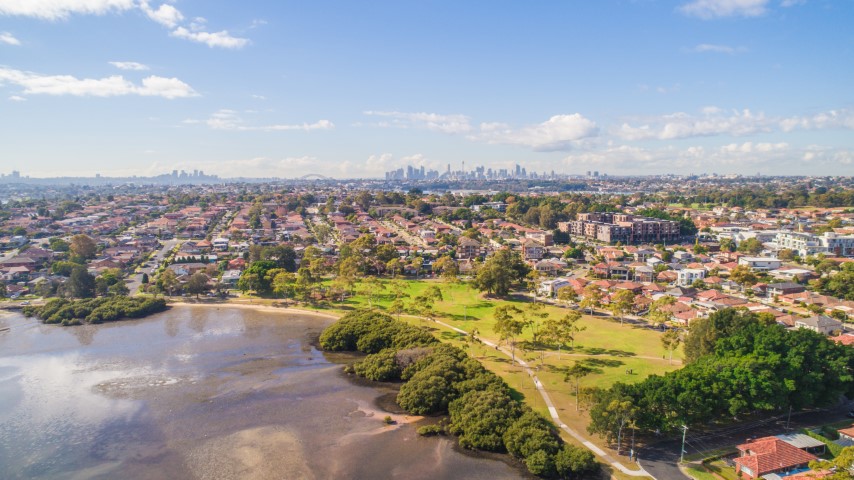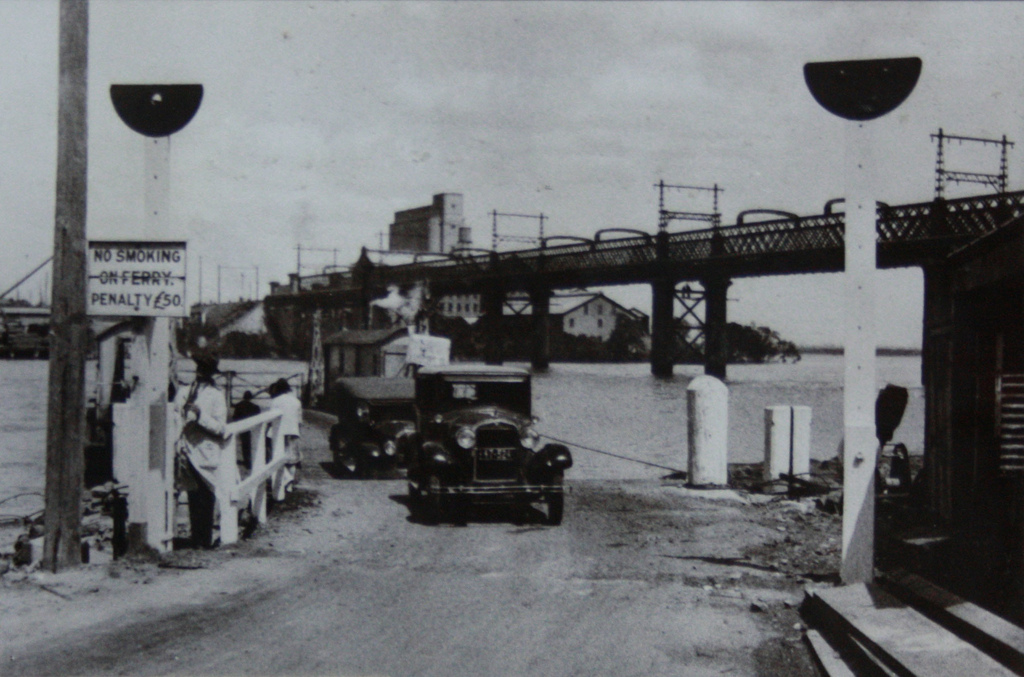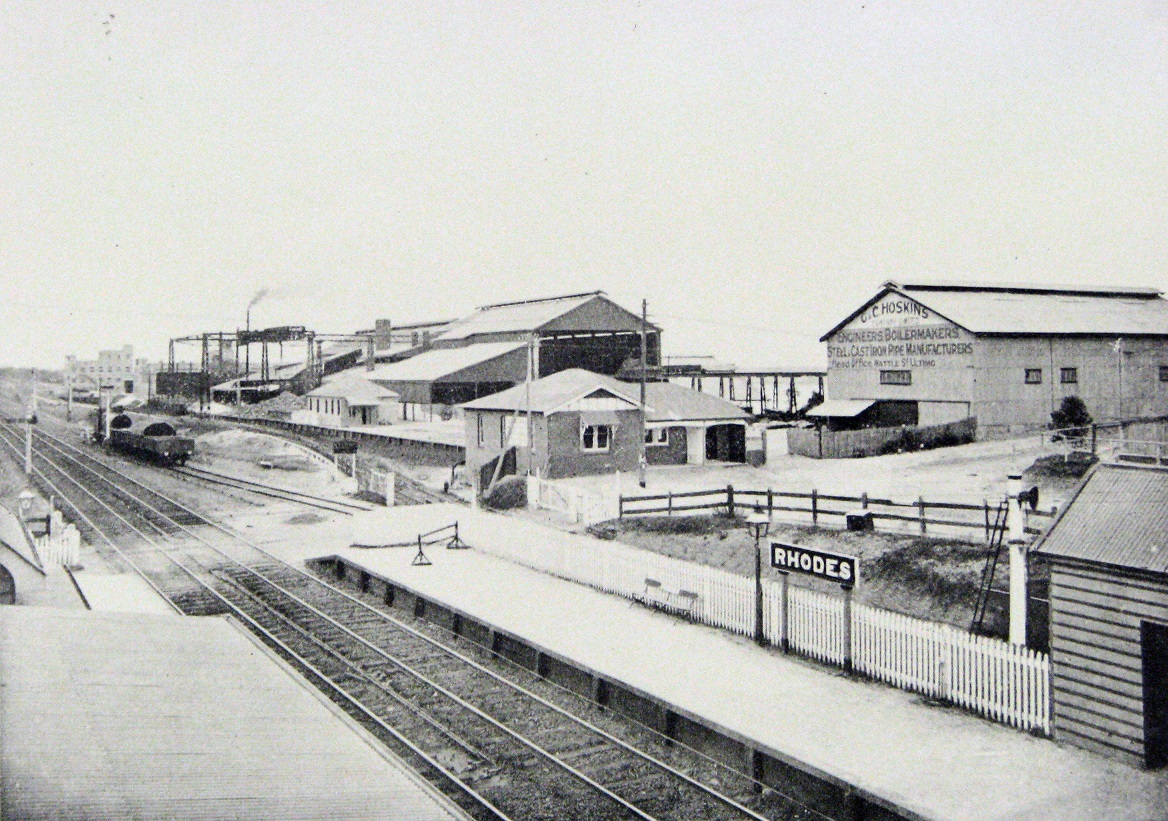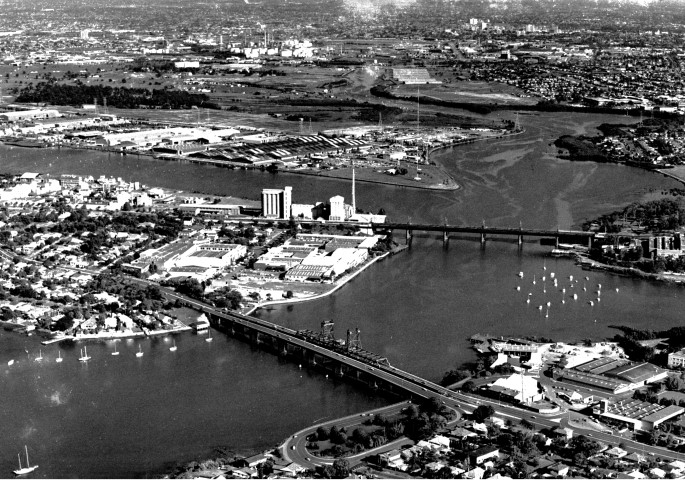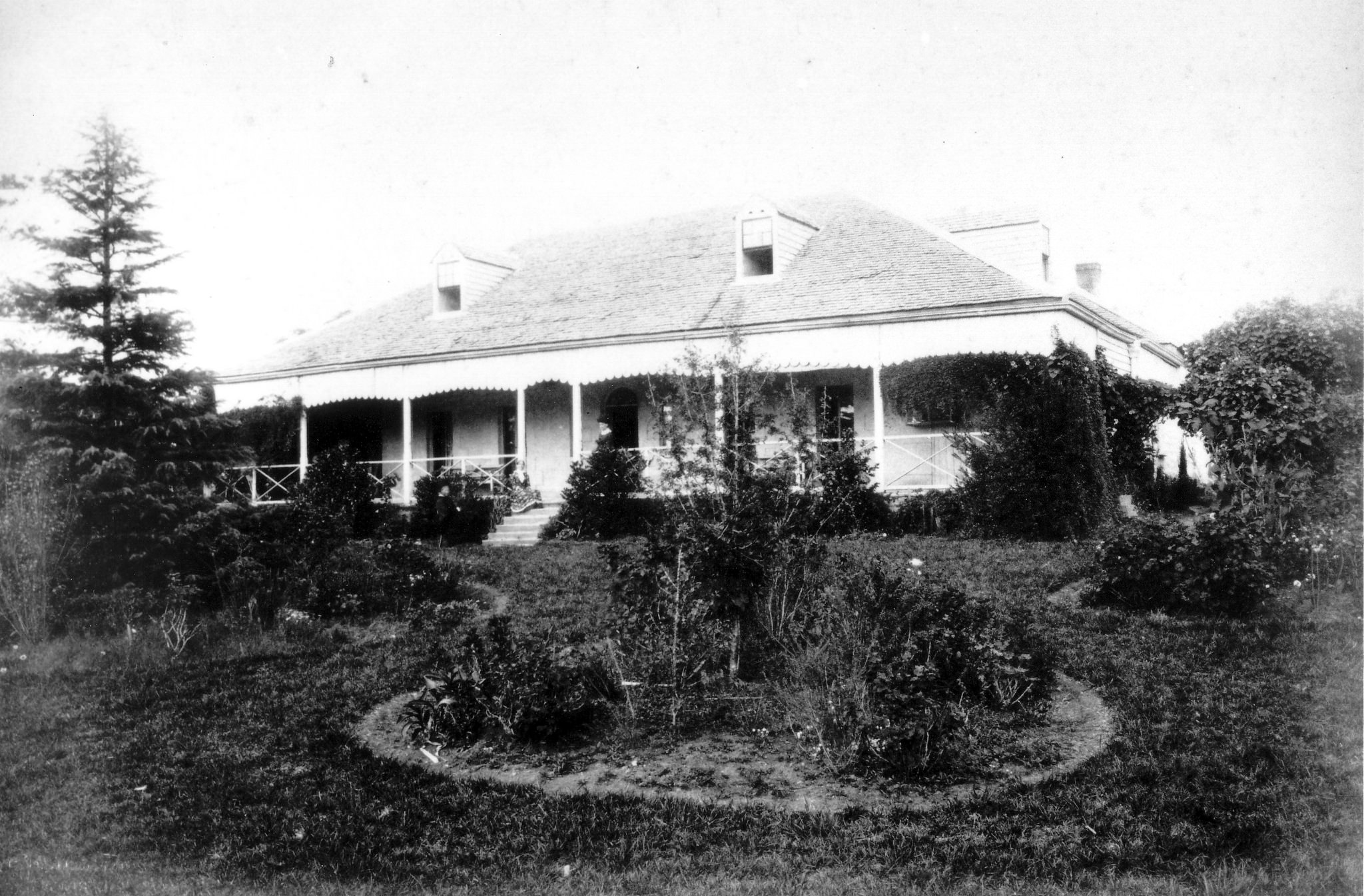Rhodes History
Prior to the arrival of the British in 1788, the Rhodes peninsula was part of the traditional lands of the Wangal Clan, one of 29 tribes of the Eora nation. The Wangal are believed to have inhabited the area for at least 15,000 years.
In 1794 the first land grants on the Rhodes peninsula were made to John Bray, Frederick Meredith and Simon Donally. This set the pattern for much of the nineteenth century with the peninsula essentially being divided between these three estates.
John Bray and his wife Mary settled on the land and by 1800 the first stage of their home Braygrove had been built. This was the first house on the Rhodes Peninsula and in the Concord area. It was later extended and remodelled by their descendants Thomas and Alfred Bray. The property remained in the Bray family until 1914 when it was purchased by Tulloch’s Phoenix Ironworks.
In 1819 Thomas Walker (1791-1861) purchased the land at Rhodes from Meredith and, following his marriage to Anna Elizabeth Blaxland in 1823, built Rhodes House. The house was named after Rhodes Hall, his mother’s ancestral home near Leeds in Britain and, in turn, gave its name to the peninsula. The estate remained in the Walker family until 1913 although sections of the estate were subdivided in 1895 and 1910. In 1918 the house was demolished to make way for the John Darling & Son flour mill.
In the 1840s George Richard Uhr, Sheriff of NSW purchased the land granted to Simon Donally and built Llewellyn House. Uhrs Point is named after him.
In 1886 the Northern Rail line between Strathfield and Hornsby was opened with a railway station at Rhodes. This provided a necessary transport link which gave impetus to industrial development along the rail line.
The landscape of Rhodes was dominated throughout much of the twentieth century by increasing industrialisation. In the early 1900s the NSW State Sawmill was established at Rhodes. This was later purchased by H. McKenzie, timber merchants and joiners who continued on the site until 1969.
G. & C. Hoskins established a pipeworks on the western side of the railway at Rhodes in 1911. CSR Chemicals Ltd purchased the site from Hoskins in 1943 and produced acetic anhydride and cellulose acetate developed in response to war needs.
Tulloch’s Phoenix Ironworks was established in 1914, between the railway and Concord Road. Initially Tulloch’s manufactured a wide range of engineered goods including railway bridges, viaducts, locomotives and rolling stock. The company also produced a range of more modest foundry goods such as wrought iron tubes and garden tools. During World War II various industries along the Parramatta River were diverted to war time production. Tulloch’s and part of the Phillip’s site became the Commonwealth Shipbuilding Yard No. 4.
For several years from 1974, Philips Industries, manufactured Malvern Star and Speedwell bicycles across the road from the Tulloch’s site, on the eastern side of Concord Road. Another engineering manufacturer, Rider and Bell Pty Ltd, started operations in Rhodes in 1920 and produced a range of automotive components, fishing and gardening equipment. It was notable as Australia’s only producer of brass firemen’s helmets.
The silos of Allied Feed Mills Pty Ltd which dominated Rhodes Point were located on the earlier site of John Darling’s flour mill established in 1919. Allied Mills, with its subsidiary, Allied Feeds, took over the flour mill in 1963. Further down the street, Timbrol Limited, a timber preservative manufacturer, was established in 1928. In 1957 Timbrol merged with the giant US Union Carbide organisation to form Union Carbide Australia Limited. Union Carbide became a major producer of chemicals, such as pesticides and herbicides, as well as extruded polyethylene film at Rhodes.
Lewis Berger & Sons (Australia) Pty Ltd was a major industry which began production in Alfred Street Rhodes in 1917. Production included white lead, linseed oil and paint. Berger’s supplied the paint required for the Sydney Harbour Bridge which opened in 1932.
Industry dominated the Rhodes landscape up until the 1980s when changing industrial needs led to industries moving away from the Peninsula. The sites were identified as prime locations for residential development. In 2004 the Rhodes Waterside Shopping Centre was completed and in 2009 the Rhodes West Master Plan was released.
Aboriginal people have lived on the peninsula for thousands of years. The area was part of the traditional country of the Wangal clan of the Darug language group who inhabited an area stretching from Parramatta to Birchgrove. The Parramatta River was not only a source of food and transport, but had spiritual significance.
The heritage of the area from pre-settlement, through to early Europeans such as Thomas Walker whose property, Rhodes, gave the suburb its name, to the industrial period and on to the formation of a new intercultural community is dynamic.
The emerging population is young, well-educated and very ethnically diverse.
The suburb of Rhodes takes its name from 'Rhodes House', which was built by Thomas Walker (not to be confused with Thomas Walker of Yaralla) in 1823. Walker named the area after Rhodes Hall, his mother’s ancestral home near Leeds in England.
Thomas Walker (1791-1861) arrived in Sydney in 1818 to take up the position of Assistant Deputy Commissary General. After a short period in Tasmania where he established a cattle farm, and built the first Rhodes House, he returned to Sydney where he married Anna Elizabeth Blaxland (the daughter of John Blaxland) and bought land at Rhodes from the original military grantee. He built a fine house which he also named 'Rhodes' after his mother’s estate in Yorkshire. A reminiscent account of the house was written in 1933 in which it was described as “prettily situated on the bank of the river, a picturesque and spacious old stone cottage with wide flagged verandahs, roomy stables and outbuildings standing in an old-world garden" (C.H. Bertie, ‘Pioneer families of Australia, No. 38: The Walkers of Rhodes’, The Home, Vol. 14, no. 2 February 1933).
In 1832, having retired from government service some years earlier, Thomas Walker took his family to Longford in Tasmania where he lived until his death in 1861. Between 1832 and 1870, Rhodes House at Concord, was leased to a number of tenants, one of whom was the well-known artist Henry Allport. In 1870 Anna Walker brought her family back to New South Wales and returned to Rhodes House, where the family lived until Anna’s death in 1889. Three of the Walker girls did not marry and continued to live at Rhodes House after their mother’s death. One of the daughters, Annie Frances Walker, established a reputation as a painter of native flora and some of her paintings are in the collection of the Mitchell Library in Sydney. She died in 1913.
The first subdivision of the Walker’s Estate in Rhodes was made in September 1895 when part of the land, along with the adjoining Llewellyn Estate of the Brays, was sold. Another section of the estate was sold in 1910.
Three streets in Rhodes today commemorate this family of pioneers: Walker Street, Blaxland Road, and Marquet Street, which was named after Anna Walkers’ eldest brother, John de Marquet Blaxland.
Rhodes House, overlooking the Parramatta River near the northern end of Blaxland Road, was demolished around 1918 to make way for the flour mill originally developed by John Darling & Son. It later became the site of Allied Feed Mills Pty Ltd. for a factory in c. 1918.
In the 70 years from 1910 to 1980 Rhodes was arguably one of Australia’s most important industrial landscapes. G&C Hoskins developed a large ironworks in 1911 which later become Hoskins Port Kembla. Several years later in 1916 Lewis Berger opened Berger Paints supplying the paint needed to paint the new Sydney Harbour Bridge in 1932.
In 1919 land at the northern end of the Peninsula was developed by John Darling Flour Mills later becoming Allied Feeds. Tullochs Phoenix Ironworks built on the site that is now Rhodes Business Park. Until the 1980s Australia’s largest chemical industries including Union Carbide, CSR Chemicals and Orica shaped Rhodes. The industrial past represents an important story line describing the nature and impacts of industries on both the river and the Peninsula. This experience has many dimensions not least that of the industrial workforce drawn from the local area.
In the 1970’s Rhodes consisted of two distinct areas – an industrial precinct to the west of the railway line and the southern section of the Peninsula and a predominately residential area to the north-east. The eastern residential section of the Peninsula remains relatively unchanged, consisting of predominately detached residential dwellings. An industrial area to the Peninsula’s north east (Leeds Street Industrial Precinct) also remains.
Remediation and redevelopment of Rhodes West industrial areas have transformed the Peninsula. Industrial sites have been replaced with a mix of retail, commercial and residential developments. These include the Rhodes Waterside Shopping Centre and Rhodes Corporate Park to the south and the current redevelopment of Rhodes West which consists of high density, transport oriented, mixed use development.
Pre 1794
Land occupied by the Wangal Clan, a tribe of the Eora Nation.
1794
Land grant to Frederick Meredith covering the western side of the Rhodes peninsula, extending south to approximate site of Rhodes Station and Mary Street. Adjacent land grants to John Bray and Simon Donally.
1819
Thomas Walker (1791-1861) purchased land at Rhodes from Meredith.
1823
Rhodes House built by Thomas Walker (1791-1861) at the time of his marriage to Anna Elizabeth Blaxland. It was named after Rhodes Hall, his mother’s ancestral home near Leeds in England.
1832
Walker family moved to Tasmania and Rhodes House leased.
1840s
George Richard Uhr purchased land at Rhodes from Simon Donally and built Llewellyn House.
1870
Anna Walker returned with her family to Rhodes House.
1883
Rhodes became part of the Municipality of Concord.
1886
Meadowbank-Rhodes Railway Bridge completed.
1886
Northern Rail line between Strathfield and Hornsby opened. Rhodes was the first railway station in Concord municipality.
1895
The first subdivision of the Walker’s Estate at Rhodes was made in September 1895 when part of the land along with the adjoining Llewellyn Estate of the Brays was sold.
1900s
NSW State Sawmill was established at Rhodes.
1910
Another section of the Walker’s Estate at Rhodes was sold.
1911
Mary Bray sold some of the Bray Estate to G. and C. Hoskins Co Ltd who established a pipe works.
1912
Land around Uhrs Point subdivided and auctioned.
1914
Robert Tulloch purchased remainder of the Bray property.
1915
Tulloch's Phoenix Ironworks established.
1918
Rhodes House demolished.
1919
John Darling & Son flour mill established.
1920
Rider & Bell Pty Ltd commenced production at Cavell Avenue, Rhodes.
1922
Rhodes Public School opened.
1923
H. McKenzie Ltd, timber and joinery merchants purchased the NSW State Sawmill.
1928
Timbrol Limited, manufacturers of timber preservatives established G. and C. Hoskins Co Ltd pipe works closed.
1930
Earth jetty established near Phillips site marked the beginnings of reclamation in this area.
1939
Reclamation work at Timbrol site.
1943
Tulloch’s became the Commonwealth Shipbuilding Yard No. 4 during World War II.
1943
CSR purchased G. and C. Hoskins Co Ltd site.
1947
CSR commenced preparation of their site for chemical manufacture.
1948
Reclamation of 4.8 hectares of Homebush Bay to accommodate the CSR factory site.
1950s
Reclamation of area now known as Rhodes Park.
1953
CSR officially opened and production of cellulose acetate commenced.
1957
Union Carbide purchased the Timbrol site and commenced production of chemicals, herbicides and pesticides.
1960
John Darling & Son taken over by Allied Mills, subsidiary Allied Feeds established on the site.
1968
Tulloch's Phoenix Ironworks foundry closed.
1969
H. McKenzie Ltd, timber and joinery site auctioned.
1974
Tulloch's Phoenix Ironworks other operations closed permanently.
1980
John Whitton Railway Bridge constructed.
1981
McIlwaine Park opened.
1988
Union Carbide undertook remediation work of their site.
1989
State Pollution Control Commission banned fishing in Homebush Bay. Rhodes Public School closed.
1990
Union Carbide site sold to Lednez which undertook some further remediation work on the site.
1994
Kokoda Track Memorial Walkway, between Brays Bay Reserve and Concord Hospital established.
1997
State Government committed to remediation of dioxin contamination of Homebush Bay.
1999
Lednez site sold to State Government for a peppercorn amount so the Government could assume responsibility for clean-up of the site.
1999
State Government gazetted the Sydney Regional Environmental Plan, establishing the Minister for Planning as authority for development within the Rhodes Peninsular redevelopment area.
2000
Rhodes became part of the City of Canada Bay when Concord and Drummoyne Councils amalgamated.
2002
Remediation report on the Lednez site (formerly Union Carbide).
2004
Rhodes Waterside Shopping Centre completed.
2005
Conservation of remnant saltmarsh vegetation at Lovedale Place, Brays Bay.
2009
Rhodes West Master Plan released.
2017
The Connection, Rhodes opened.

